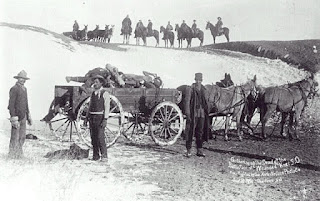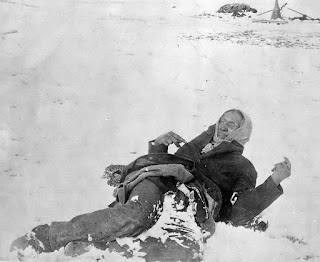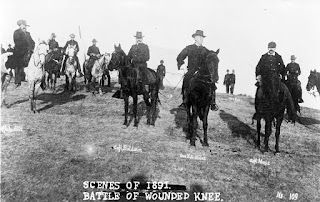La masacre de Wounded
Knee ocurrió en 1890, hace 130 años, cuando los soldados del ejército norteamericano dispararon
contra hombres (la mayoría desarmados), mujeres y niños de la reserva indígena de
Pine Ridge. Más de 200 nativos
murieron…
En vocabulario: botched and squaw
By the time the
massacre was over, more than 250 men, women, and children of the Lakota had
been killed and 51 were wounded…
The Pioneer has
before declared that our only safety depends upon the total extermination of
the Indians…
The Wounded Knee Massacre was a domestic massacre of several hundred Lakota people, by soldiers of the United States Army. It occurred on
December 29, 1890, near Wounded Knee
Creek on the Lakota Pine Ridge Indian
Reservation in the U.S. state of South Dakota, following a botched attempt to disarm the Lakota camp.
One version of
events claims that during the process of disarming the Lakota, a deaf tribesman named Black Coyote was reluctant to give up his rifle, claiming he had
paid a lot for it. Simultaneously, an old man was performing a ritual called the Ghost Dance. Black Coyote's rifle went off at that point, and the U.S. Army began shooting at the Native Americans. The Lakota warriors fought back, but
many had already been stripped of their guns and disarmed.
 |
| Víctimas de la masacre trasladadas en un carro |
By the time
the massacre was over, more than 250 men, women, and children of the Lakota had
been killed and 51
were wounded (4 men and 47 women and children, some of whom died later); some
estimates placed the number of dead as high as 300. Twenty-five soldiers also
died, and thirty-nine were wounded (six of the wounded later died). Twenty
soldiers were awarded the Medal of Honor.
Eyewitness accounts
American Horse (1840–1908); chief, Oglala Lakota:
"... A
mother was shot down with her infant; the child not knowing that its mother was
dead was still nursing ... The women as they were fleeing with their babies
were killed together, shot right through ... and after most all of them had
been killed a cry was made that all those who were not killed or wounded should
come forth and they would be safe. Little boys ... came out of their places of
refuge, and as soon as they came in sight a number of soldiers surrounded them
and butchered them there."
 |
| Bigfoot muerto en la masacre |
Edward S. Godfrey; captain; commanded Co. D of the 7th Cavalry:
"I know the
men did not aim deliberately and they were greatly excited. I don't believe
they saw their sights. They fired rapidly but it seemed to me only a few
seconds till there was not a living thing before us; warriors, squaws, children, ponies, and
dogs ... went down before that unaimed fire."
Hugh McGinnis; First Battalion, Co. K, 7th Cavalry:
"… He also
discovered to his horror that helpless children and women with babies in their
arms had been chased as far as two miles from the original scene of encounter
and cut down without mercy by the troopers... "
The American public's reaction to the
massacre at the time was generally favorable. Many non-Lakota living near the reservations interpreted the battle as
the defeat of a murderous cult; others confused Ghost Dancers with Native
Americans in general. In an editorial response to the event, the young
newspaper editor L. Frank Baum, later
the author of The Wonderful Wizard of Oz,
wrote in the Aberdeen Saturday Pioneer
on January 3, 1891:
The Pioneer has before declared that our only safety depends upon
the total extermination of the Indians.
Having wronged them for centuries, we had better, in order to protect our
civilization, follow it up by one more wrong and wipe these untamed and
untamable creatures from the face of the earth. In this lies future safety for
our settlers and the soldiers who are under incompetent commands.
Otherwise, we may expect future years to be as full of trouble with the
redskins as those have been in the past.
 |
| Oficiales en Wounded Knee (el de la izq. Buffalo Bill) |
For this 1890
campaign, the US Army awarded 20 Medals of Honor, its highest
commendation.
Native American activists have urged the medals be withdrawn, calling them
"medals of dishonor". According to Lakota tribesman William
Thunder Hawk, "The Medal of
Honor is meant to reward soldiers who act heroically. But at Wounded Knee, they didn't show heroism;
they showed cruelty."
Vocabulario
Botched: (of a task) carried out badly or carelessly.
"A botched attempt to steal a car"
Squaw: The English word squaw
is an ethnic and sexual slur, historically used for Indigenous North American women. Contemporary use of the term,
especially by non-Natives, is
considered offensive, derogatory, misogynist and racist.
Traducción
Más de 200 nativos fueron masacrados por los
soldados del 7° de caballería en Wounded
Knee. También se señala que
ü la
mayoría de los indios estaba desarmada
ü se
los persiguió y disparó
ü en
el momento se lo consideró positivamente
ü fueron
condecorados
Artículos
relacionados
Llevaba su largo rifle con él a todas horas durante
la filmación para permanecer en su personaje… Daniel
Day-Lewis
Su mamá proviene de una importante familia en Costa
Rica… Madeleine
Stowe
Studi nació en Nofire Hollow, Oklahoma, y solo habló
cherokee…
Esto es parte
del archivo: The Last of the Mohicans
No comments:
Post a Comment